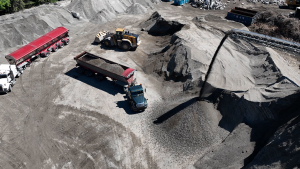Ken Meinert is stuck in a place called Samsonite, living out of a suitcase, somewhere between New Orleans and Georgia and it’s a long way from the CEO’s offices of CGC.
Making A Difference
Former CGC CEO puts his skills to work as part of the massive rebuild
Ken Meinert is stuck in a place called Samsonite, living out of a suitcase, somewhere between New Orleans and Georgia and it’s a long way from the CEO’s offices of CGC.
But he perseveres because he knows thousands of people’s lives will be all the poorer for it if he packs it in and heads home before his job is finished.
An accomplished engineer, corporate executive and entrepreneur, Meinert is currently Habitat for Humanity’s senior vice president responsible for Operation Home Delivery, a rebuilding effort created to house people along the U.S. Gulf Coast left homeless by hurricanes Katrina and Rita.
“He’s working out of a place called Samsonite, living out of a suitcase between an office in New Orleans, an office in Georgia and our organization in Canada,” says David Hughes, president and CEO of Habitat for Humanity Canada. “Ken’s first stage efforts were about assessing the condition of our 17 affiliates in the region, and working with consultants from McKinsey & Company to assess that damage and the condition of homes in the area. The first report is that it will require well over a year – if not several years – for an all out rebuilding effort to begin.”
Part of the problem in rebuilding the approximately 500,000 homes that have been damaged or destroyed is the condition of the surrounding infrastructure, including reliable power, water and sanitation services.
Meinert has more than 25 years experience working in senior leadership positions within the construction industry in Canada, the United States and Europe. He was president and CEO of CGC Inc., a leading manufacturer of gypsum construction materials, vice president of U.S. Gypsum Co, president and chief operating officer of KML Engineered Homes Inc., and owner of a privately held production and construction company.
“We are extremely fortunate to find someone of Kenneth’s caliber to lead this initiative,” said Jonathan Reckford, CEO of Habitat for Humanity International. “In addition to being a highly skilled construction industry executive, he comes to us with a track record of using innovative building methods to solve problems. This will prove invaluable as we set out to rebuild communities in conditions where there is almost no infrastructure left behind and where we will need to find new ways of building homes.”
Meinert began his relationship with Habitat as a volunteer on a build site in St. John’s, NFLD and as a corporate sponsor while at CGC. This was followed by several years on the Habitat for Humanity national board of directors.
Hughes says that Habitat for Humanity will initially concentrate on building homes where infrastructure is sound and future flooding is unlikely.
For example, the Canadian organization recently sent money to help purchase land in Louisiana for a new 86-home development on higher ground.
“Until the breaks in the levees are repaired, there are some limits to how and where we will rebuild,” says Meinert.
Hughes says that getting Habitat for Humanity’s Gulf region affiliates up and running has been a first priority, preparing them to participate in the organization’s innovative “House-in-a-Box” program, which delivers prefabricated housing panels to affected areas.
Local volunteers build foundations while some of the more than 1,700 Habitat for Humanity affiliates and partners across North America prepare the building components for shipping by truck.
The organization has delivered material to the region as of mid-December, with several houses already under construction.
Canada is also providing building expertise.
A recent conference held in Atlanta to discuss Gulf Coast rebuilding efforts featured input from a contingent of Canadians, including members of Habitat for Humanity Canada, and representatives from CMHC and the Canadian lumber industry.
The conference focused on the comparative merits of pre-cut, panelized and modular construction to respond to the need for increased housing output in the region.
“Public and private builders may have to increase housing output in the area up to tenfold,” says Hughes. “We see this as an opportunity to rethink how we’re building homes. Our Canadian operation hopes to provide some of the systems that will help bring scale and automation to the house building process. What we’re using as a model is the auto industry – using technical solutions to increase the speed of building coordination, shipping and assembly. But we also have to make sure that, with all of the technical innovations, our projects are still volunteer-friendly.”
The first of its “House-in-a-Box” units to families build in Canada for those left homeless by Hurricane Katrina will be shipped next month.
Meanwhile, Habitat has contributed to the purchase of a plot of land in the Bayou area, just west of New Orleans, where they will build approximately 86 Habitat for Humanity homes.
Habitat for Humanity Canada is partnering with Thibodaux, LA-based Bayou Area Habitat for Humanity affiliate, which serves the Terrebonne and Lafourche Parishes.
In these two parishes 16,000 homes were damaged or destroyed by Hurricanes Katrina and Rita.
“The unprecedented need for housing created by these disasters is forcing public and private builders to consider alternative methods and processes to increase output exponentially” said Hughes. “The innovations brought to bear on this situation will have long-term positive implications on our ability to meet the housing need here in Canada on a much larger scale”.
Since the hurricanes struck the U.S. Gulf Coast in late August 2005, Habitat for Humanity Canada has received unprecedented support from individuals and organizations wanting to help those families who won’t have a home for the holidays.
Operation Home Delivery is a three-phased response program established by Habitat for Humanity International to lead the rebuilding of Hurricane Katrina impacted areas along the Gulf Coast.
Team Canada Expert Missions which will provide Canadian expertise to those involved in rebuilding homes and revitalizing Habitat for Humanity affiliates within the region.
“The rebuilding of the Gulf Coast and other affected areas is a long and arduous task – this is only the beginning,” says Meinert










Recent Comments
comments for this post are closed